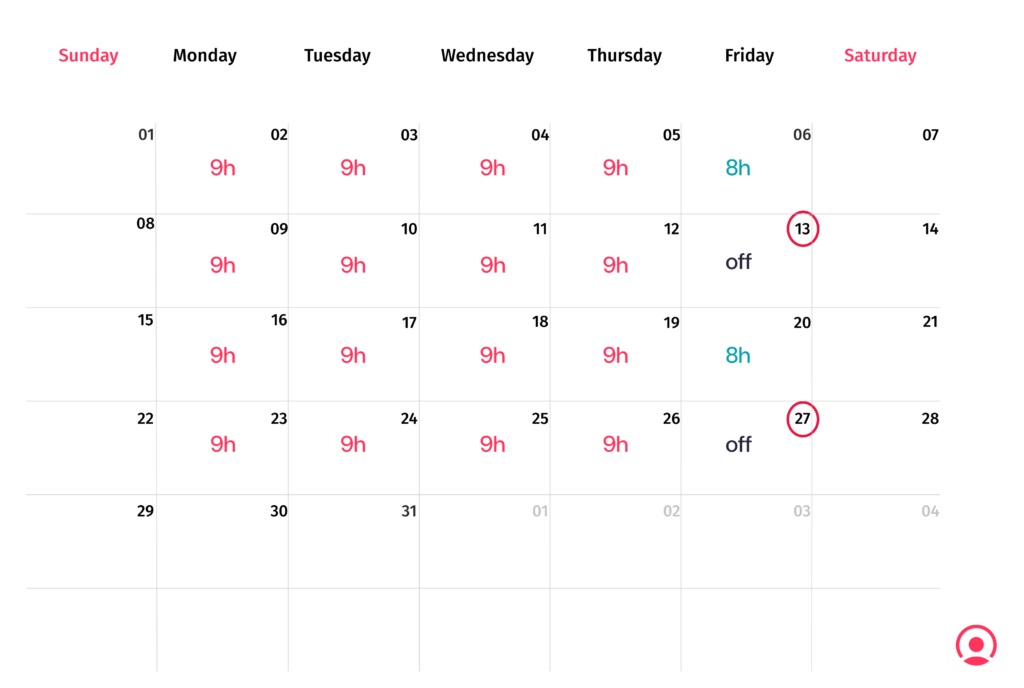The working world is shifting from a traditional nine-to-five, 40-hour workweek. Instead, increasing numbers of employers are opting for more flexible work schedules in an attempt to offer a better work-life balance and improve employee productivity, engagement, and satisfaction. One such example is the 9/80 work schedule.
In fact, according to a study by the Society for Human Resource Management (SHRM), approximately 27% of US employers now offer a compressed work schedule, with the 9/80 schedule being one of the most popular options. But it’s not for everyone.
So, what is a 9/80 work schedule exactly? How do you implement it? And would it work in your organization?
Let’s find out.
TABLE OF CONTENTS
How does a 9/80 work schedule work?
What are the benefits of a 9/80 work schedule?
What are some of the drawbacks of a 9/80 work schedule?
How to implement a 9/80 schedule
Managing flexible and changing schedules
Using shift management software 🚀
What is a 9/80 work schedule?
When it comes to flexible working schedules, there are many choices available these days. You can offer swing shift hours or a 4-day work week, for example. Or, as many businesses are now doing, you can implement a 9/80 work schedule.
But what does a 9/80 work schedule mean?
A 9/80 schedule is a type of alternative, compressed work schedule that involves working 80 hours over nine days instead of the traditional 10 days of work per two-week pay period (hence the name: 9 days/80 hours). This means that employees work nine working days (excluding weekends), followed by a day off, and then work another nine working days before taking a second day off. Although a relatively new concept, this type of schedule meets the approval of the Department of Labor under certain conditions, including adherence to overtime and minimum wage laws.
How does a 9/80 work schedule work?
We’ve seen what it is, but how does it work in practice?
There are many different ways that organizations can implement a 9/80 work schedule. The most common structure is when employees work eight 9-hour days and one 8-hour day and have one extra day off every two weeks. This day off is usually on a Friday.
For example:
| Week 1 Monday: 9 hours Tuesday: 9 hours Wednesday: 9 hours Thursday: 9 hours Friday: 8 hours Total hours worked: 44 hours |
Week 2 Monday: 9 hours Tuesday: 9 hours Wednesday: 9 hours Thursday: 9 hours Friday: Day off Total hours worked: 36 hours |
As you can see, keeping track of employee working hours is essential if you are going to implement a 9/80 work schedule. The best solution for this is using an employee time tracker application. That way, you keep a record of when employees clock in and out each day and you can be sure that they are sticking to their assigned 9/80 schedule. More on this below.
What are the benefits of a 9/80 work schedule?
Provided it’s right for the specific needs of your business, working shifts with a 9/80 work schedule can offer a number of benefits to both employers and employees.
Let’s take a look at some of the advantages.
Improved work-life balance
Under the right conditions, a 9/80 work schedule can offer your employees an improved work-life balance. How? Because they get an extra day off every two weeks. They can use this extra day to spend time with family and friends and engage in hobbies or other interests. This additional time away from work can also help employees reduce stress and avoid burnout, leading to greater job satisfaction and improved overall health and well-being.
Reduced commuting time
By working longer hours on fewer days, employees can reduce their overall commuting time and avoid rush hour traffic. Employees can also use the extra day off to schedule appointments or run errands during off-peak hours, when traffic is lighter, and lines are shorter. This can help employees better manage their personal lives and reduce the time and stress associated with commuting.
Increased productivity
One of the most significant benefits of a 9/80 work schedule is the potential for increased productivity. With longer workdays, employees have more uninterrupted time to complete tasks. They can also avoid distractions that might arise during a traditional work schedule. Plus, by having an extra day off to rest and recharge, employees can return to work feeling refreshed and focused. All this can result in higher levels of productivity and better job performance.
Increased motivation
Many employees appreciate the flexibility of a 9/80 work schedule. They value that their employers have implemented measures to accommodate their needs and preferences, and this can lead to increased motivation, engagement, and loyalty. Additionally, with an extra day off every two weeks, employees have more time to pursue personal interests and hobbies, which can help them feel more fulfilled and energized when they return to work. All this helps you foster a more positive and motivated working environment, leading to better organizational performance.
Attracting and retaining talent
Finally, when potential new recruits see that a business offers alternative options such as a 9/80 work schedule, it boosts the organization’s employer brand and helps the company attract and retain top talent. What’s more, by offering a 9/80 work schedule, employers can demonstrate their commitment to employee well-being and a healthy work-life balance, which can improve overall job satisfaction and employee retention rates. All this can help you become more competitive in the job market and help you build a strong, committed, and productive workforce.
What are some of the drawbacks of a 9/80 work schedule?
While a 9/80 work schedule offers several benefits, there are also some potential disadvantages to consider.
Let’s explore some of the issues that you might encounter.
Fatigue and burnout
One potential drawback of a 9/80 work schedule is the risk of fatigue and burnout. Since workdays are longer, employees may feel more tired and stressed, especially as they approach the end of the workday or workweek. The extra day off every two weeks may help employees recharge, but it may not be enough to fully recover from the long hours.
Additionally, if employees are not given enough time to rest and recover between shifts, they might become fatigued or overwhelmed, which can lead to decreased productivity, poor job performance, and increased absenteeism. Employers should be aware of the risk of fatigue and burnout when implementing a 9/80 work schedule and take steps to mitigate these risks, such as offering additional breaks during the workday or providing support to employees who are feeling overwhelmed.
Scheduling conflicts
Another potential drawback of a 9/80 work schedule is the risk of scheduling conflicts. Since the 9/80 schedule is not a standard work schedule, it may be difficult to coordinate with clients, partners, or colleagues who work traditional schedules or operate on a different work schedule. This can create communication gaps, missed opportunities, and conflicts that can be detrimental to business operations. Additionally, if employees are not given adequate notice of changes to their schedule, they may have trouble balancing work and personal commitments, leading to stress and dissatisfaction.
Make sure you implement measures to address these potential scheduling conflicts. For example, scheduling software can help you notify employees of any shift changes when they occur and establish clear communication channels.
Not suitable for all employees
Although many employees will like the idea of a 9/80 work schedule, it’s not for everyone. For example, some employees may be unwilling or unable to work an extra hour a day as a result of personal commitments or caregiving responsibilities. Or employees with longer commutes or other obligations might find it difficult to commit to a 9/80 schedule.
Make sure you consider the needs and preferences of all your employees when you implement a 9/80 work schedule. It’s also a good idea to offer flexible scheduling options where possible to accommodate those who may not be able to work a compressed schedule.
Issues with overtime
Overtime could be an issue if employees don’t stick to their specific work hours. For example, if an employee works late to complete a project before their extra day off, you might end up paying more overtime than you planned. This shouldn’t be a problem if it only happens once or twice a month. But if it happens more often, the extra expense is going to start cutting into your bottom line.
Another issue in this regard is that you might have trouble tracking and calculating overtime hours. This can lead to errors in payroll, misunderstandings, and potential legal issues if employees are not compensated for their overtime work. Plus you need to account for overtime if non-exempt employees go over a 40-hour week with your schedule format (more on overtime implications below).
The key to overcoming this potential drawback is making sure that employees understand the importance of sticking to their schedule where possible. It’s also important to make sure you have a reliable system in place for tracking employee hours and processing payroll.
Miscommunication and collaboration issues
Finally, you might encounter issues with communication and collaboration if you don’t have the right technology to support a 9/80 work schedule. This is especially true if you have remote workers on this schedule.
Firstly, if employees are off on different days, it may be difficult for them to communicate effectively with each other. For example, if a team member needs to ask a question, they may have to wait an extra day to get a response if the other team member is not working. This delay can slow down project timelines and hinder productivity.
A 9/80 work schedule can also make it more challenging to schedule meetings or group discussions if employees are off on different days. These issues can be particularly problematic for teams that work on complex or time-sensitive projects that require close coordination and cooperation. That’s why it’s so important to have reliable communication channels in place before you implement this type of schedule.
How to implement a 9/80 schedule
Implementing a 9/80 work schedule requires careful planning and communication. But with the right approach, it can offer significant benefits to both employers and employees.
Here’s everything you need to keep in mind.
Check labor laws
There are no federal laws specifically governing the 9/80 work schedule. However, there are labor laws that apply to all types of work schedules.
For example, according to the Fair Labor Standards Act (FLSA), employers must pay non-exempt employees overtime pay for any hours that they work over a 40-hour workweek. So, if you follow the 9/80 schedule example that we gave at the start of the post, then employees would work 44 hours in week 1, and 36 hours in week 2. As a result, non-exempt employees on this schedule would be eligible for overtime pay for the 4 additional hours that they work. You also need to make sure you comply with the federal minimum wage set by the FLSA.
Secondly, make sure you check whether there are any laws governing alternative work schedules in your state. For instance, California has specific laws governing alternative work schedules, including the 9/80 schedule. Employers in this state must obtain approval from the California Division of Labor Standards Enforcement before implementing a 9/80 schedule. Moreover, the alternative workweek schedule must be approved by at least two-thirds of affected employees in a secret ballot election. Employers must also meet certain requirements regarding work hours and overtime pay.
Evaluate feasibility for your business
As we mentioned in the intro, a 9/80 work schedule doesn’t work for every organization. For example, some organizations may have specific operational requirements that make it difficult to schedule work hours in this way. Others might not have enough work to justify the extended hours or have workloads that require them to work more than 9 hours a day. That’s why it’s so important to carefully consider the nature of your business and operations. You also need to consider employee roles and responsibilities and the potential benefits and drawbacks of a 9/80 schedule.
Consult with your employees
It’s also a good idea to consult with your employees to find out whether or not they would be interested in working a 9/80 schedule. You could even share a survey or hold a focus group to gather feedback and address concerns. Ultimately, unless the majority of your workforce is on board, then this form of scheduling is unlikely to work for you.
Develop a 9/80 work schedule plan
Based on the feedback you receive, develop a plan for how you will implement your 9/80 work schedule. This plan should include details on which employees will be eligible for the schedule, how the schedule will be structured, and how it will be communicated to employees.
Will schedules be fixed or flexible? Which day of the week will employees have off? Will this day be consistent for all employees or will days off be staggered? And will you use an employee schedule template or shift scheduling software to manage your employee shifts more efficiently?
How to plan shifts for a 9/80 work schedule plan
1. Understand the 9/80 Schedule:
Ensure everyone understands the concept of the 9/80 work schedule, where employees work eight 9-hour days and one 8-hour day in a two-week period.
2. Define the Work Week:
Establish which day of the week will serve as the starting point for the workweek. Typically, it’s Monday or another day based on the needs of the business.
3. Create Shift Patterns:
Develop shift patterns that align with the 9/80 schedule. For example:
- Week 1: Monday to Friday (9 hours each), Day off (8 hours)
- Week 2: Monday to Friday (9 hours each), Day off
4. Communicate the Schedule:
Clearly communicate the shift schedule to all employees. Provide details on start and end times, break periods, and any variations due to holidays or other considerations.
5. Address Overtime:
Clearly outline how overtime will be handled. If an employee works more than the designated hours, ensure that overtime policies are in place and communicated.
6. Consider Departmental Needs:
Take into account the specific needs of each department when planning shifts. Some departments may require coverage during specific hours, and the schedule should accommodate these requirements.
7. Accommodate Time-Off Requests:
Establish a process for handling time-off requests and ensure that employees have the opportunity to request days off within the constraints of the 9/80 schedule.
8. Rotate Days Off:
Implement a fair rotation for days off to distribute the days off evenly among employees. This can help prevent any single employee or group of employees from consistently having the same days off.
9. Monitor and Adjust:
Regularly monitor the effectiveness of the 9/80 schedule. Collect feedback from employees and be willing to make adjustments if necessary to address any issues or concerns.
10. Address Compliance:
Ensure that the shift planning complies with labor laws and regulations regarding working hours, breaks, and overtime.
11. Use Scheduling Tools:
Consider using scheduling software or tools to automate the process and make it easier to manage and communicate shifts.
Review your payroll and time-tracking systems
Another important step in implementing a 9/80 work schedule is making changes to your payroll system. This includes updating pay periods, overtime calculations, and other aspects of the payroll system to accommodate the new schedule.
You also need to make sure you have a reliable system in place for employee time tracking, including any overtime hours worked. This is especially important in the case of remote employee time tracking. The best solutions for this include time card apps, timesheet software, or any other type of time clock for small business.
All this will help you stay compliant with state and federal laws governing meal and rest breaks. It will also make it much easier to generate accurate payslips at the end of each pay period.
Communicate 9/80 work schedule plan to your employees
Once you have developed your plan, communicate it to your employees. Provide clear information on how the 9/80 schedule will work. Also make sure you explain the benefits of the schedule, and any potential drawbacks or limitations.
Monitor and evaluate your 9/80 work schedule
Finally, regularly monitor and evaluate your 9/80 schedule to see how effective it is. Gather feedback from employees and make adjustments to your schedule as needed.
Managing flexible and changing schedules
Perhaps the most important thing to consider is how you will manage flexible and changing schedules.
Factorial’s shift management software can be a valuable tool for this. The software offers a range of features designed to simplify and streamline the scheduling process. It can also help you stay compliant with labor laws and regulations.
One key feature of Factorial’s software is its ability to automate shift scheduling. Employers can easily create, manage, and communicate employee schedules using the software, reducing the chances of scheduling conflicts. That way, managers can ensure that employees are scheduled for the appropriate number of hours each week. The software also makes it easier to approve or deny time off requests and update schedules accordingly.
Factorial’s time-tracking features can also help you get the benefits of a 9/80 work schedule while reducing the risk of some of the drawbacks we listed above. For example, the software can track the number of hours that your employees work. This includes any overtime hours and breaks. You can also generate detailed reports on employee time and attendance. That way, you can be sure that you are compensating your employees fairly for their work. You can also rest assured that you are complying with all legal requirements.
Ultimately, with the right planning and technology, a 9/80 work schedule can provide a number of crucial benefits. Most notably, this includes an improved work-life balance, increased productivity, and enhanced employee satisfaction.
Why not give it a go?




